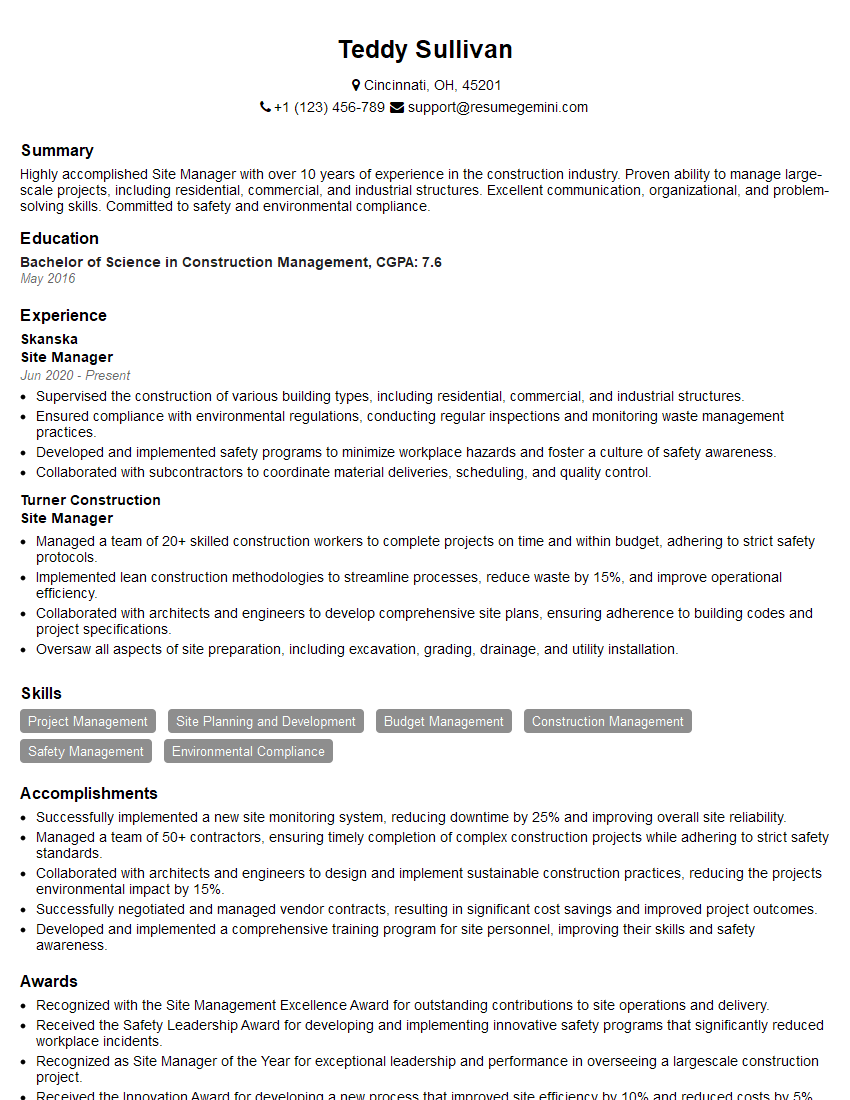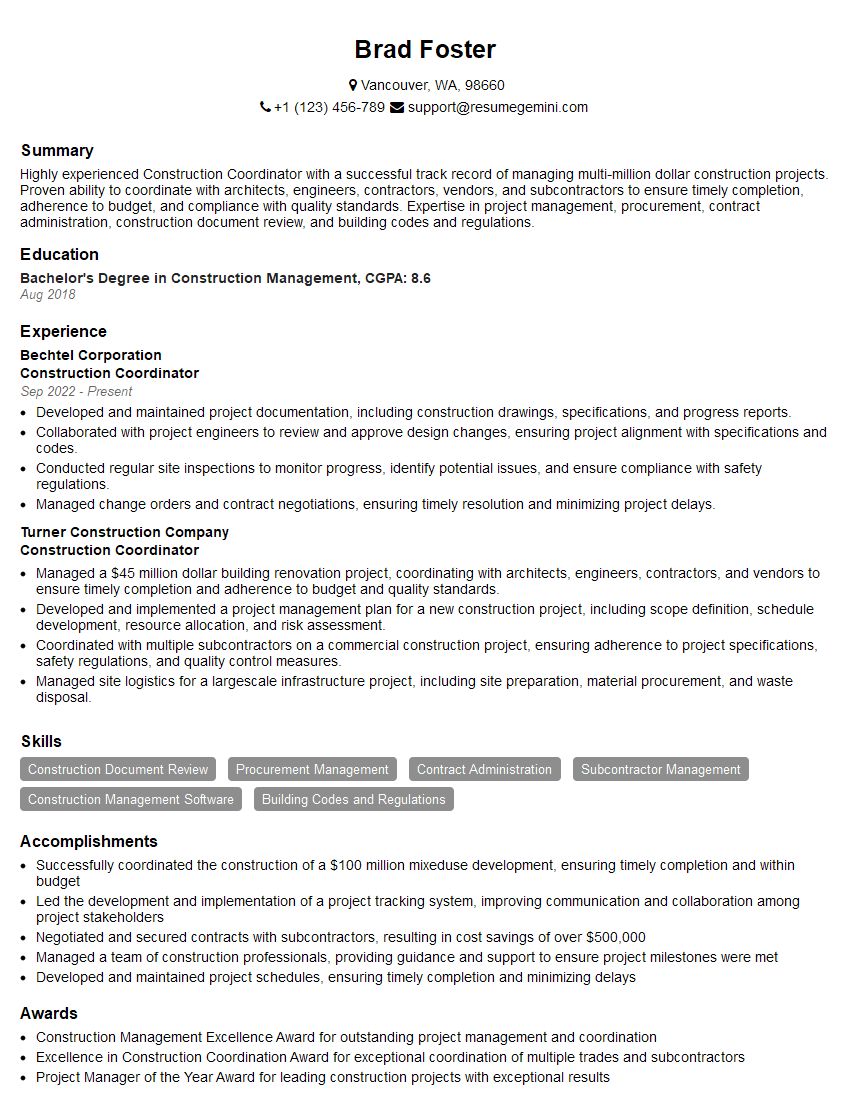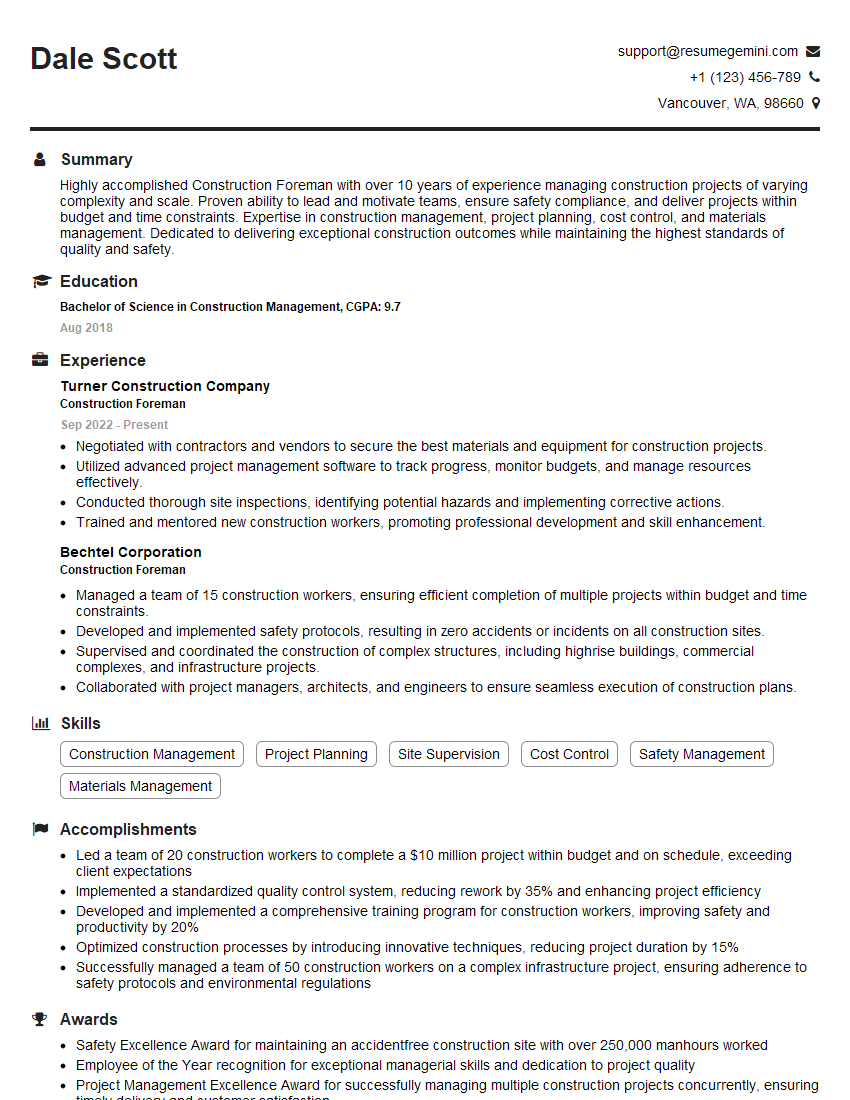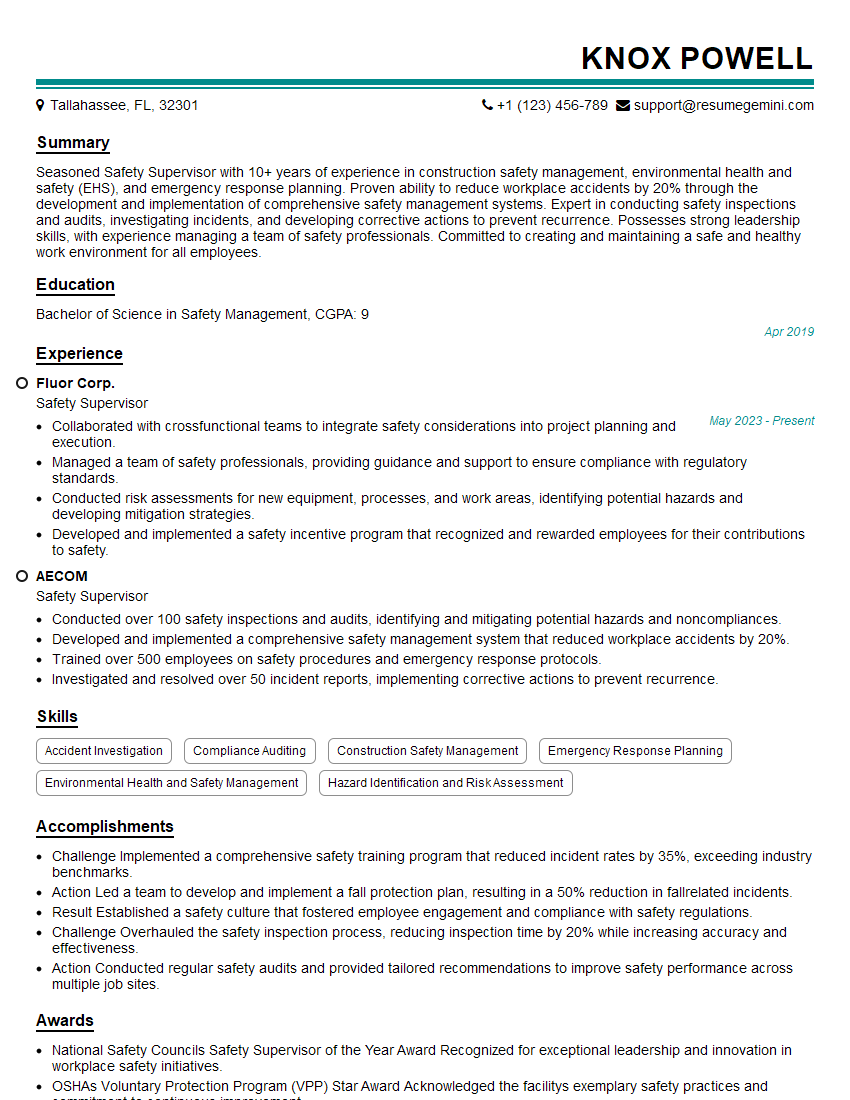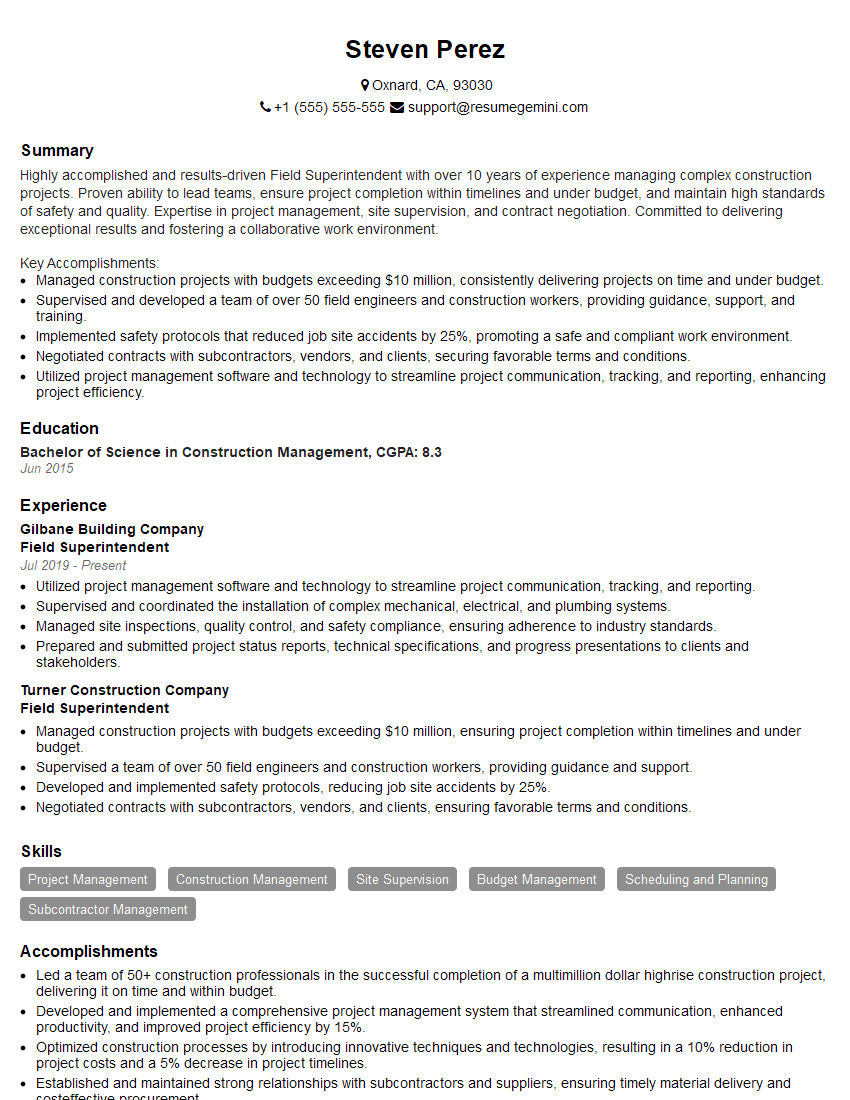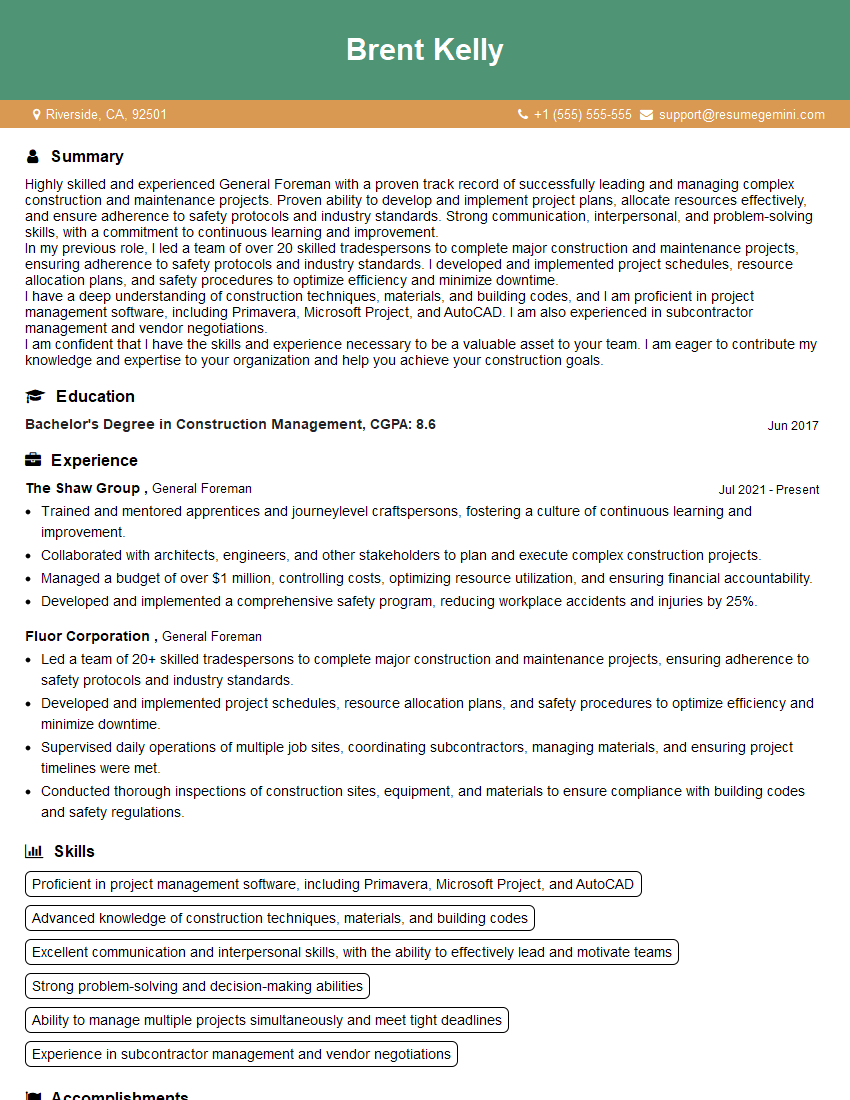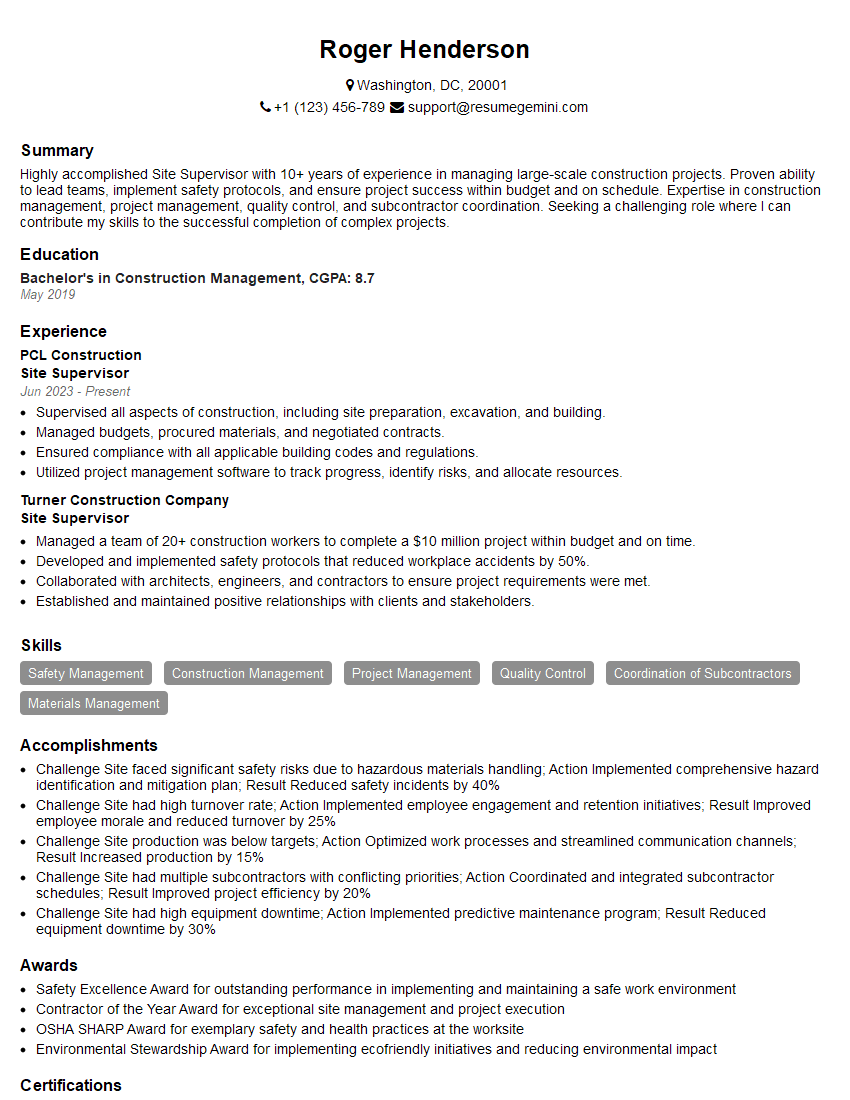Cracking a skill-specific interview, like one for Supervision and coordination of jobsite activities, requires understanding the nuances of the role. In this blog, we present the questions you’re most likely to encounter, along with insights into how to answer them effectively. Let’s ensure you’re ready to make a strong impression.
Questions Asked in Supervision and coordination of jobsite activities Interview
Q 1. Describe your experience in developing and implementing jobsite safety plans.
Developing and implementing a robust jobsite safety plan is paramount to ensuring a safe working environment. It’s not just about ticking boxes; it’s about fostering a culture of safety. My approach begins with a thorough site-specific risk assessment, identifying potential hazards like trench collapses, electrical hazards, or falling objects. This assessment involves walking the site, reviewing blueprints, and consulting with subcontractors.
Next, I translate these identified risks into a comprehensive safety plan. This plan details preventative measures, emergency procedures, and employee responsibilities. For instance, if trenching is involved, the plan will specify the requirements for shoring, sloping, and daily inspections. For electrical work, it will outline lockout/tagout procedures and the use of personal protective equipment (PPE). The plan is then communicated to all workers through toolbox talks, safety meetings, and readily accessible documentation.
Beyond initial implementation, continuous monitoring is key. I conduct regular site inspections, ensuring compliance with the safety plan and identifying any new hazards. I also track incident reports, analyze near-misses, and use this data to refine the plan and improve safety practices. For example, a near-miss involving a falling object might lead to implementing stricter fall protection measures or improving material handling procedures. This iterative process ensures the safety plan remains relevant and effective throughout the project lifecycle.
Q 2. How do you manage multiple priorities and deadlines on a construction site?
Managing multiple priorities and deadlines on a construction site requires a structured approach. I utilize project management tools, such as Gantt charts, to visualize task dependencies and critical paths. This allows me to identify potential bottlenecks and proactively adjust schedules. I also employ daily huddles with the crew to review progress, identify any emerging issues, and coordinate tasks. This ensures everyone is on the same page and working towards common goals.
Prioritization is crucial. I use a combination of methods, including the Eisenhower Matrix (urgent/important), to identify tasks that require immediate attention and those that can be delegated or rescheduled. Transparent communication with clients and subcontractors is essential. Regular updates keep stakeholders informed about progress and potential challenges, preventing surprises and allowing for collaborative problem-solving. A flexible approach is necessary too; unexpected delays happen, and adaptability is key to maintaining momentum.
Q 3. Explain your process for managing and motivating a construction crew.
Managing and motivating a construction crew requires a blend of leadership styles. I believe in leading by example, demonstrating hard work and commitment to the project’s success. I foster open communication, encouraging workers to share their ideas and concerns. Regular one-on-one meetings help me understand individual challenges and provide personalized support.
Positive reinforcement is crucial. I recognize and celebrate achievements, both big and small, boosting team morale and reinforcing good work habits. Fairness and consistency in treatment are essential. I ensure that all team members feel valued and respected, regardless of their role or seniority. This fosters a collaborative and positive environment where everyone feels empowered to contribute their best. Addressing conflicts swiftly and fairly is important to maintain productivity and avoid negativity.
Q 4. What methods do you use to track project progress and identify potential delays?
Tracking project progress and identifying potential delays involves a multi-faceted approach. I rely on a combination of methods, including regular site inspections, daily progress reports from subcontractors, and the use of project management software. This software allows me to track tasks, monitor milestones, and visually represent progress against the schedule.
Regular meetings with the project team facilitate early identification of potential roadblocks. By analyzing variances from the planned schedule, I can anticipate and address potential delays. For example, if material deliveries are consistently late, I can proactively work with the supplier to find solutions or adjust the schedule accordingly. Detailed documentation of daily activities, including any unforeseen events or delays, enables accurate reporting and analysis of overall project performance.
Q 5. How do you handle conflicts or disagreements among team members on a jobsite?
Handling conflicts among team members requires a fair and impartial approach. I encourage open dialogue, creating a safe space for team members to express their concerns without fear of reprisal. Active listening is key to understanding the root cause of the disagreement. Once I understand the perspectives of all parties involved, I can facilitate a collaborative solution.
In some cases, mediation may be necessary. I act as a neutral facilitator, guiding the team members towards a mutually acceptable resolution. If the conflict persists despite my intervention, I may need to impose a resolution, but this is always a last resort. The focus is always on maintaining a positive and productive work environment, which requires addressing conflicts constructively and reinforcing respectful communication.
Q 6. Describe your experience with budget management and cost control on construction projects.
Budget management and cost control are critical aspects of successful construction projects. I begin by thoroughly reviewing the project budget, understanding the allocated funds for each task and material. Throughout the project, I carefully track expenses, comparing actual costs against the budget. This involves regularly reviewing invoices from subcontractors and suppliers and verifying the accuracy of costs.
Value engineering is a crucial tool for cost control. I explore alternative materials or methods that achieve the same results at a lower cost, without compromising quality or safety. Regular meetings with the project team allow for early detection of potential cost overruns. For instance, if material costs are increasing unexpectedly, I can proactively look for alternative suppliers or renegotiate contracts to minimize the impact on the budget. Accurate forecasting and contingency planning are vital to ensure the project stays within budget.
Q 7. How do you ensure compliance with all relevant building codes and regulations?
Ensuring compliance with building codes and regulations is non-negotiable. I start by thoroughly familiarizing myself with all relevant codes and regulations specific to the project location. This includes reviewing local ordinances, state regulations, and national building codes. I then incorporate these requirements into the project plans and specifications.
Regular inspections are conducted throughout the project lifecycle to ensure ongoing compliance. I work closely with inspectors to address any discrepancies or non-conformities promptly. Maintaining detailed documentation, including permits, inspection reports, and test results, is crucial for demonstrating compliance. Employee training on relevant codes and regulations ensures everyone understands their responsibilities in maintaining compliance. Proactive measures, such as pre-construction meetings with inspectors to discuss potential challenges, can significantly reduce delays and issues later in the project.
Q 8. Explain your experience with using project management software (e.g., Procore, Primavera P6).
My experience with project management software is extensive, encompassing both Procore and Primavera P6. Procore is my go-to for daily task management, document control, and communication. I utilize its features to track RFIs (Requests for Information), submittals, and issues, keeping the project on schedule and within budget. For instance, on a recent high-rise project, I used Procore’s drawing management tools to ensure everyone had access to the latest revisions, preventing costly errors. Primavera P6, on the other hand, is invaluable for complex scheduling and resource allocation. I’ve used it to create detailed critical path schedules, identifying potential delays early on. On a large-scale renovation project, P6 helped us optimize the deployment of our trades, minimizing conflicts and maximizing efficiency. The software’s reporting capabilities are also beneficial for providing transparent progress updates to clients and stakeholders.
Q 9. Describe a time you had to solve a complex problem on a jobsite. What was your approach?
During the construction of a waterfront residential development, we encountered a significant problem with unexpected bedrock formations that were not revealed during the initial geotechnical survey. This meant that the original foundation design was inadequate and threatened to derail the project schedule and budget. My approach involved a multi-step process. First, I immediately halted work in the affected area to prevent further complications and ensure worker safety. Then, I convened a meeting with the geotechnical engineer, structural engineer, and the contractor to assess the situation. We analyzed the new data and explored multiple solutions. We ultimately decided on a revised foundation design that accounted for the bedrock. This involved detailed cost-benefit analysis of different solutions and securing approval for the change order from the client. Open communication and proactive problem-solving were key to successfully navigating this obstacle, minimizing the overall impact on the project timeline.
Q 10. How do you ensure effective communication between the project team, subcontractors, and clients?
Effective communication is paramount in construction. I employ a multi-pronged approach. Regular project meetings, both in-person and virtual (using platforms like Zoom or Microsoft Teams), are crucial for keeping everyone informed. These meetings involve the entire team, including subcontractors and the client’s representatives. I also use Procore’s communication tools for daily updates, issue tracking, and RFI responses. This creates a central hub for all project-related discussions, ensuring no information falls through the cracks. For complex issues, I favor face-to-face communication to ensure a clear understanding and to build rapport. Finally, I create concise and regular progress reports for the client, keeping them fully informed about the project’s status, highlighting any challenges and proposed solutions.
Q 11. What is your experience with quality control procedures on a construction site?
My experience with quality control is rooted in proactive measures, ensuring adherence to plans and specifications from the outset. I implement rigorous inspection protocols at each stage of construction. This includes daily inspections by myself and my team, focusing on critical aspects like concrete strength testing, dimensional accuracy, and material compliance. We utilize checklists and photographic documentation to record the progress and any deviations. Subcontractors are required to provide their own quality control documentation, which I review thoroughly. Any discrepancies are immediately addressed, employing a ‘stop-work’ order if necessary until the issue is resolved. This proactive approach not only ensures a quality product but also prevents costly rework later in the project.
Q 12. How do you address safety violations or near misses on a jobsite?
Safety is my top priority. Upon observing a safety violation or near miss, my immediate response is to stop the work in the affected area and ensure the safety of everyone involved. I then thoroughly investigate the incident, interviewing witnesses and documenting the details. The investigation focuses on identifying the root cause of the violation – whether it’s inadequate training, equipment failure, or a procedural lapse. I then implement corrective actions, ranging from retraining workers to revising safety protocols or replacing faulty equipment. This incident is also documented in the project’s safety log and shared with the client and all relevant parties. Finally, a follow-up meeting is held to reinforce the importance of safety and prevent similar occurrences.
Q 13. Describe your experience with scheduling and resource allocation on construction projects.
Scheduling and resource allocation are key skills for effective project management. I utilize Primavera P6 to create detailed schedules, accounting for the dependencies between different tasks and the availability of resources. This involves understanding the critical path, optimizing the sequence of work to minimize delays, and efficiently allocating resources such as labor, equipment, and materials. I also factor in potential risks and buffer time to account for unforeseen circumstances. Regularly monitoring the schedule for variances and adapting to changing circumstances is essential. On a recent project, adjusting the schedule and reallocating resources allowed us to overcome a delay caused by inclement weather, keeping the project on track.
Q 14. How do you handle unexpected changes or challenges on a construction site?
Unexpected challenges are inevitable in construction. My approach involves a systematic response. First, I assess the situation calmly and gather information to fully understand the nature and scope of the problem. Then, I bring together the relevant team members – engineers, subcontractors, and potentially the client – to brainstorm solutions. We analyze various options, considering their impact on the schedule, budget, and overall project quality. Transparency is crucial here – keeping everyone informed about the situation and the proposed solutions. Once a plan is agreed upon, we implement it, monitoring progress closely and making adjustments as necessary. Thorough documentation of the change and its impact on the project is maintained for future reference.
Q 15. What is your experience with risk management in construction projects?
Risk management in construction is crucial for project success. It involves identifying, assessing, and mitigating potential hazards that could affect the project’s timeline, budget, or safety. My approach is proactive and systematic, utilizing a combination of qualitative and quantitative methods.
- Hazard Identification: I use a variety of tools, including checklists, brainstorming sessions, and site inspections, to pinpoint potential risks. For example, on a recent high-rise project, we identified the risk of material shortages due to supply chain disruptions.
- Risk Assessment: Once hazards are identified, I assess their likelihood and potential impact using a risk matrix. This allows us to prioritize risks based on their severity. In the material shortage example, we assessed the probability as ‘medium’ and the impact as ‘high,’ prompting immediate action.
- Risk Mitigation: I develop and implement strategies to reduce or eliminate identified risks. For the material shortage, we secured multiple suppliers, established buffer stock, and negotiated long-term contracts. We also implemented a real-time inventory tracking system.
- Monitoring and Review: Throughout the project, I regularly monitor and review the effectiveness of our risk mitigation strategies, adjusting them as needed. This dynamic approach ensures our response is always relevant to the current project situation.
This multi-faceted approach allows me to effectively manage risk and minimize its negative impacts on the project.
Career Expert Tips:
- Ace those interviews! Prepare effectively by reviewing the Top 50 Most Common Interview Questions on ResumeGemini.
- Navigate your job search with confidence! Explore a wide range of Career Tips on ResumeGemini. Learn about common challenges and recommendations to overcome them.
- Craft the perfect resume! Master the Art of Resume Writing with ResumeGemini’s guide. Showcase your unique qualifications and achievements effectively.
- Don’t miss out on holiday savings! Build your dream resume with ResumeGemini’s ATS optimized templates.
Q 16. Describe your experience with subcontractor management and coordination.
Subcontractor management requires strong communication, coordination, and a clear understanding of contractual obligations. My experience involves overseeing everything from the selection process to final payment.
- Selection and Qualification: I thoroughly vet subcontractors, assessing their experience, qualifications, insurance, and safety records. This process ensures we work only with reputable and capable partners.
- Contract Negotiation and Management: I ensure contracts are detailed, covering scopes of work, payment schedules, and performance expectations. I closely monitor their performance and resolve any conflicts promptly and fairly. For example, on a recent project, a subcontractor experienced delays. Through clear communication and a collaborative approach, we adjusted the schedule to minimize project impact.
- Coordination and Communication: Effective communication is paramount. I conduct regular meetings with subcontractors to discuss progress, address challenges, and ensure coordination across different trades.
- Performance Monitoring and Evaluation: I utilize progress reports, site inspections, and regular communication to track performance and identify any potential issues early on. This proactive approach allows us to address problems before they become major setbacks.
Building strong relationships with subcontractors based on trust and mutual respect is essential for successful project delivery.
Q 17. How do you ensure timely completion of projects within budget constraints?
Ensuring timely and budget-conscious project completion requires careful planning, efficient execution, and proactive problem-solving. I employ a multi-pronged strategy:
- Detailed Project Planning: I develop comprehensive project schedules using tools like Microsoft Project or Primavera P6, breaking down tasks into manageable components. This allows for precise tracking of progress and identification of potential delays.
- Resource Allocation: I carefully allocate resources—labor, materials, and equipment—to optimize efficiency and avoid bottlenecks. For example, I might strategically schedule certain tasks to utilize available equipment effectively.
- Cost Control and Budgeting: I utilize cost tracking software and regular budget reviews to monitor expenditures and identify areas for potential cost savings. This often involves leveraging market analysis to find the most cost-effective materials and suppliers.
- Progress Monitoring and Reporting: I regularly monitor progress against the schedule and budget, generating reports to highlight any variances and initiate corrective action promptly. This proactive approach ensures problems are addressed before they snowball.
- Change Management: I have a well-defined process for managing change orders, assessing their impact on the budget and schedule, and negotiating fair adjustments.
This proactive approach helps to maintain projects on track, preventing cost overruns and delays.
Q 18. What is your approach to mentoring and training junior team members?
Mentoring and training junior team members is crucial for developing a skilled and motivated workforce. I believe in a hands-on, supportive approach that combines practical experience with theoretical knowledge.
- On-the-Job Training: I provide opportunities for junior team members to learn by doing, gradually increasing their responsibilities. I carefully monitor their performance and provide guidance and feedback.
- Formal Training Programs: I encourage and support junior team members to participate in industry-relevant training courses and workshops to enhance their skills.
- Mentorship Programs: I develop mentoring relationships with junior team members, providing guidance, support, and career advice. This can involve regular one-on-one meetings to discuss professional development and challenges.
- Constructive Feedback: I provide regular and constructive feedback, focusing on both strengths and areas for improvement. I create a supportive learning environment where open communication and constructive criticism are encouraged.
My goal is not just to train junior team members but to nurture their professional growth and help them achieve their full potential. I believe a well-trained team is a successful team.
Q 19. Explain your experience with material management and inventory control.
Material management and inventory control are essential for avoiding delays and cost overruns. My approach focuses on accuracy, efficiency, and minimizing waste.
- Material Procurement Planning: I meticulously plan material procurement, considering lead times, quantities needed, and potential supply chain disruptions. This planning often utilizes detailed material take-offs from project plans.
- Inventory Tracking Systems: I utilize inventory tracking software to monitor materials on hand, ensuring sufficient quantities are available and minimizing waste from overstocking.
- Storage and Handling: I implement proper storage and handling procedures to protect materials from damage and theft. This includes clear labeling, appropriate storage locations, and regular inspections.
- Waste Reduction Strategies: I implement strategies to minimize material waste, including careful planning, accurate ordering, and efficient use of materials on site. This might involve techniques like pre-fabrication or efficient cutting methods.
Efficient material management translates to smoother project execution and minimizes financial losses due to material shortages or spoilage.
Q 20. How do you handle change orders and their impact on project timelines and budgets?
Change orders are a common occurrence in construction projects. My approach prioritizes clear communication, prompt assessment, and efficient implementation.
- Formal Change Order Process: I adhere to a formal process for handling change orders, ensuring all requests are documented, reviewed, and approved according to the project’s contractual agreements.
- Impact Assessment: I carefully assess the impact of each change order on the project schedule and budget, developing revised schedules and cost estimates.
- Negotiation and Agreement: I negotiate fair and reasonable adjustments with the client, clearly documenting any changes to the contract.
- Implementation and Monitoring: I ensure the change order is implemented correctly and monitor its impact on the project’s overall progress and budget.
By managing change orders effectively, I prevent disputes and maintain control over the project’s scope, schedule, and cost.
Q 21. Describe your experience with using various construction tools and equipment.
My experience encompasses a wide range of construction tools and equipment, both manual and mechanized. This includes proficiency in operating and maintaining equipment such as excavators, bulldozers, cranes, concrete pumps, and various surveying instruments.
- Safe Operation Procedures: I strictly adhere to safe operating procedures for all equipment, ensuring operator certification and regular equipment maintenance checks.
- Equipment Selection: I make informed decisions on selecting the appropriate tools and equipment for specific tasks based on the project’s needs and site conditions.
- Maintenance and Upkeep: I understand the importance of equipment maintenance and upkeep, ensuring regular servicing and repairs to maximize equipment lifespan and minimize downtime.
- Problem Solving: I can quickly diagnose and troubleshoot equipment issues, minimizing delays and ensuring project continuity.
A thorough understanding of construction tools and equipment enables efficient and safe project execution.
Q 22. What are your preferred methods for documenting jobsite progress and activities?
My preferred methods for documenting jobsite progress and activities are multifaceted and prioritize accuracy, accessibility, and real-time updates. I utilize a combination of digital and physical tools. This approach ensures a comprehensive record and minimizes potential discrepancies.
Daily Logs/Reports: I meticulously maintain daily logs, detailing weather conditions, worker attendance, equipment usage, tasks completed, and any issues encountered. These are often supplemented with photographs or short video clips to visually document progress.
Digital Project Management Software: Platforms like Asana, Monday.com, or similar software are essential for tracking tasks, deadlines, resource allocation, and communication amongst the team. This allows for real-time monitoring of progress and facilitates collaboration.
Photographs and Videos: I regularly take photos and videos of critical stages, from foundation work to final inspections. This serves as visual proof of progress and can be invaluable in case of disputes or insurance claims. A drone can be highly effective for capturing a broader perspective of the site.
Formal Progress Reports: Weekly or bi-weekly formal reports summarizing key accomplishments, challenges faced, and future plans are submitted to clients and stakeholders. These reports use clear and concise language and frequently incorporate charts and graphs to visualize progress against the project timeline.
For example, on a recent high-rise construction project, using a combination of daily logs, project management software, and drone footage allowed us to identify a minor structural issue early on, minimizing costs and project delays.
Q 23. How do you stay informed about the latest industry trends and technologies?
Staying informed about the latest industry trends and technologies is crucial for maintaining a competitive edge and ensuring project efficiency. My approach is multi-pronged:
Industry Publications and Journals: I regularly subscribe to and read trade publications like Engineering News-Record (ENR) and other relevant journals to stay abreast of new materials, techniques, and regulations.
Conferences and Workshops: Attending industry conferences and workshops provides opportunities to network with peers, learn from experts, and discover emerging technologies firsthand. I actively participate in Q&A sessions and workshops.
Online Courses and Webinars: Numerous online platforms offer courses and webinars on various aspects of construction management. This allows for convenient, targeted learning on specific areas of interest.
Networking: I actively participate in professional organizations like the Associated General Contractors of America (AGC) to connect with colleagues and learn about best practices and innovative solutions. This includes attending local chapter meetings and engaging in online forums.
Technology Demonstrations and Site Visits: Whenever possible, I attend technology demonstrations and site visits to witness new technologies in action and learn about their practical applications.
For instance, recently, I attended a workshop on the application of Building Information Modeling (BIM) in construction, which has significantly improved our project planning and coordination.
Q 24. What is your approach to ensuring the safety of all workers on the jobsite?
Ensuring worker safety is paramount. My approach is proactive and preventative, based on a strong safety culture ingrained from the project’s inception.
Comprehensive Safety Training: All workers undergo thorough safety training before commencing work, covering site-specific hazards, proper use of equipment, and emergency procedures. Refresher courses are conducted regularly.
Regular Safety Inspections: I conduct regular inspections to identify and mitigate potential hazards. These inspections are documented, and corrective actions are implemented promptly.
Implementation of Safety Protocols: Strict adherence to safety protocols, including the use of Personal Protective Equipment (PPE), is enforced consistently. This includes regular checks to ensure compliance.
Incident Reporting and Investigation: A robust system for reporting and investigating incidents, both near misses and actual accidents, allows us to identify root causes and implement preventative measures. We use a standardized reporting form and conduct thorough investigations.
Safety Meetings and Communication: Regular safety meetings are held to discuss safety concerns, review incidents, and reinforce safe work practices. Open communication channels encourage workers to report any unsafe conditions without fear of reprisal.
For example, on a recent project, our proactive safety measures prevented a potential fall from height by identifying and correcting a hazard during a routine inspection.
Q 25. How do you create and maintain a positive and productive work environment?
Creating a positive and productive work environment is crucial for project success. My strategy focuses on fostering collaboration, clear communication, and mutual respect.
Open Communication: I encourage open communication among team members and foster a culture of transparency. Regular team meetings, both formal and informal, are held to discuss progress, challenges, and ideas.
Fair and Consistent Treatment: I ensure that all team members are treated fairly and consistently, regardless of their role or background. This involves clear expectations and consistent enforcement of rules and regulations.
Recognition and Appreciation: I actively recognize and appreciate the contributions of individual team members, both publicly and privately. This fosters a sense of accomplishment and boosts morale.
Conflict Resolution: I address conflicts promptly and fairly, using mediation techniques to find mutually acceptable solutions. This prevents minor disagreements from escalating into larger problems.
Team Building Activities: Organized team-building activities, both on and off-site, strengthen relationships and improve collaboration. This can be something as simple as a casual lunch or a more structured event.
In a recent project, by fostering a collaborative environment, we were able to successfully navigate a complex scheduling challenge, completing the project ahead of schedule and under budget.
Q 26. Describe your experience with conducting jobsite inspections and audits.
My experience in conducting jobsite inspections and audits is extensive, encompassing various stages of construction projects. I follow a systematic approach to ensure thoroughness and objectivity.
Pre-Construction Inspections: These inspections verify that the site is prepared correctly, including utility locations, access points, and compliance with pre-construction plans.
Regular Progress Inspections: I conduct regular inspections throughout the construction process, verifying compliance with plans, specifications, and safety regulations. This typically involves checklists and detailed documentation.
Quality Control Inspections: These focus on the quality of workmanship and materials, ensuring that they meet the required standards. Specific testing procedures might be employed.
Safety Audits: Regular safety audits identify potential hazards and ensure compliance with safety regulations. Corrective actions are documented and implemented.
Final Inspections: These are comprehensive inspections carried out before project completion, verifying that the work meets all requirements and standards before project handover.
I utilize checklists and standardized forms for consistency and to ensure that all aspects are covered. For example, during a recent inspection, a minor discrepancy in the electrical wiring was identified and corrected before it could pose a safety hazard.
Q 27. How do you manage logistics and transportation on a construction site?
Managing logistics and transportation on a construction site requires meticulous planning and coordination. My approach focuses on efficiency, safety, and minimizing disruptions.
Site Layout and Access Planning: Careful planning of the site layout, including designated areas for material storage, equipment parking, and worker access, is crucial for smooth operations.
Material Scheduling and Delivery: I collaborate with suppliers to schedule material deliveries to minimize on-site storage and prevent congestion. Just-in-time delivery is often preferred.
Equipment Management: A schedule for equipment usage and maintenance ensures optimal utilization and prevents downtime. This includes tracking fuel consumption and maintenance schedules.
Traffic Management: Implementing traffic control measures, including designated routes and speed limits, ensures the safety of workers and vehicles on site.
Waste Management: A comprehensive waste management plan ensures proper disposal of construction waste in accordance with environmental regulations.
For instance, on a recent project, implementing a streamlined delivery schedule reduced material storage costs by 15% and improved site accessibility.
Q 28. Explain your experience in resolving permitting and regulatory issues.
Resolving permitting and regulatory issues requires a thorough understanding of local, state, and federal regulations. My approach involves proactive planning and efficient communication.
Proactive Permitting: I work closely with engineers and architects to ensure that all necessary permits are obtained well in advance of construction. This includes gathering all required documentation.
Regulatory Compliance: I maintain up-to-date knowledge of all relevant regulations and ensure that the project complies with all applicable codes and standards. This often involves consultations with regulatory bodies.
Communication with Regulatory Agencies: I maintain open communication with relevant regulatory agencies, addressing any concerns promptly and professionally. This proactive approach can prevent delays.
Issue Resolution: Should issues arise, I work collaboratively with regulatory agencies and other stakeholders to find solutions that meet all requirements while minimizing disruptions to the project schedule.
Documentation and Record Keeping: I maintain meticulous records of all permits, approvals, and communications with regulatory agencies. This is crucial for compliance and auditing.
For example, on a project where a permit was delayed, proactive communication with the relevant authority allowed us to resolve the issue efficiently, minimizing the impact on the project timeline.
Key Topics to Learn for Supervision and Coordination of Jobsite Activities Interview
- Safety Management: Understanding and implementing comprehensive safety protocols, including OSHA regulations, hazard identification, risk assessment, and incident reporting. Practical application: Describe your experience in creating and enforcing safety plans on a jobsite, including specific examples of how you mitigated risks.
- Team Leadership and Communication: Effectively leading and motivating a team, fostering collaboration, providing clear instructions, and managing conflict resolution. Practical application: Share examples of how you delegated tasks, provided constructive feedback, and built strong working relationships with diverse teams.
- Project Scheduling and Coordination: Developing and managing project timelines, coordinating resources (materials, equipment, personnel), and tracking progress against deadlines. Practical application: Describe your experience using project management tools or methodologies (e.g., Gantt charts, Agile) to ensure timely completion of projects.
- Resource Allocation and Management: Optimizing resource utilization, managing budgets, and ensuring efficient allocation of materials and equipment. Practical application: Explain how you’ve successfully managed budgets and resources to complete projects on time and within budget.
- Quality Control and Assurance: Implementing quality control measures, conducting inspections, and ensuring adherence to project specifications and standards. Practical application: Describe your experience in identifying and resolving quality issues, and implementing corrective actions to prevent future occurrences.
- Problem-Solving and Decision-Making: Identifying and analyzing problems on the jobsite, developing and implementing effective solutions, and making sound decisions under pressure. Practical application: Share examples of challenging situations you faced and how you effectively resolved them using critical thinking and problem-solving skills.
- Reporting and Documentation: Maintaining accurate and up-to-date records, preparing progress reports, and communicating effectively with clients and stakeholders. Practical application: Discuss your experience with various reporting methods and tools, and how you ensured clear and timely communication of project status.
Next Steps
Mastering supervision and coordination of jobsite activities is crucial for career advancement in construction and related fields. It demonstrates your ability to lead teams, manage projects effectively, and ensure a safe and productive work environment. To maximize your job prospects, create an ATS-friendly resume that clearly highlights your skills and experience. ResumeGemini is a trusted resource that can help you build a professional and impactful resume. We provide examples of resumes tailored to Supervision and coordination of jobsite activities to guide you in showcasing your qualifications effectively.
Explore more articles
Users Rating of Our Blogs
Share Your Experience
We value your feedback! Please rate our content and share your thoughts (optional).
What Readers Say About Our Blog
Hello,
We found issues with your domain’s email setup that may be sending your messages to spam or blocking them completely. InboxShield Mini shows you how to fix it in minutes — no tech skills required.
Scan your domain now for details: https://inboxshield-mini.com/
— Adam @ InboxShield Mini
Reply STOP to unsubscribe
Hi, are you owner of interviewgemini.com? What if I told you I could help you find extra time in your schedule, reconnect with leads you didn’t even realize you missed, and bring in more “I want to work with you” conversations, without increasing your ad spend or hiring a full-time employee?
All with a flexible, budget-friendly service that could easily pay for itself. Sounds good?
Would it be nice to jump on a quick 10-minute call so I can show you exactly how we make this work?
Best,
Hapei
Marketing Director
Hey, I know you’re the owner of interviewgemini.com. I’ll be quick.
Fundraising for your business is tough and time-consuming. We make it easier by guaranteeing two private investor meetings each month, for six months. No demos, no pitch events – just direct introductions to active investors matched to your startup.
If youR17;re raising, this could help you build real momentum. Want me to send more info?
Hi, I represent an SEO company that specialises in getting you AI citations and higher rankings on Google. I’d like to offer you a 100% free SEO audit for your website. Would you be interested?
Hi, I represent an SEO company that specialises in getting you AI citations and higher rankings on Google. I’d like to offer you a 100% free SEO audit for your website. Would you be interested?
good

